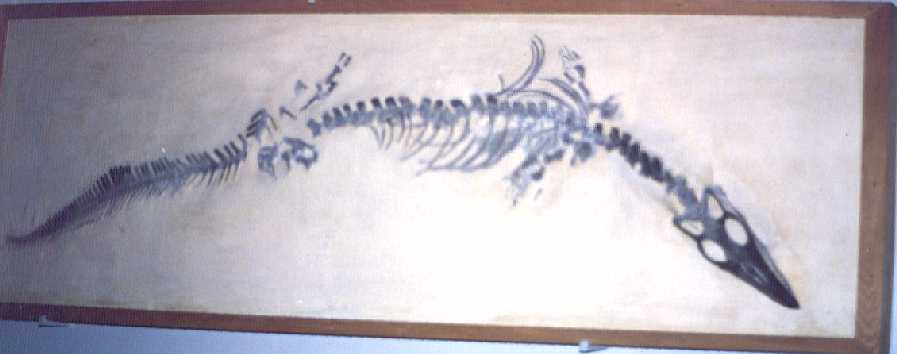 |
Kansas Mosasaurs in Sweden:
The type specimen of Eonatator
(Halisaurus; Clidastes)
sternbergi Wiman 1920.
Copyright © 1999-2010 by Mike Everhart
Created 10/30/1999: Last updated
08/08/2010
LEFT: A photograph of the type
specimen of Halisaurus (Clidastes) sternbergi in the Museum of Evolution,
Uppsala, Sweden (by Johan Lindgren). |
NOTE: The genus name has been changed from Halisaurus to Eonatator
("Dawn swimmer") by Bardet, et al., 2005.
"A little Clidastes skeleton found by my son Levi proves not only
to be new, but possessed of remarkable characters not yet described. I will only in a
general way give you an idea of this little sea lizard. It is 8 ½ feet long, skull 14
inches long. Levi in preparing the skeleton restored the maxilla, jugals, nasals and
prosquamosals, with the ends of some of the teeth; also four of the cervical and one
dorsal vertebra. These had been destroyed by incrusting gypsum. The bifrucated coracoids,
2 inches wide, are large compared to the scapulę, which are only 1 ¼ inches wide. The
most remarkable thing about this mosasaur is the fact that the humeri and femora have
distinct, round heads, similar to those of mammals. Further, all the Clidastes humeri I
know are broad, square bones, nearly as broad as they are long. In this specimen the
humerus is 2 ¼ inches, while it is only 1 ¼ inches wide in the widest part; the same
with the femur. The front paddle is 7 inches long to ends of first row of phalanges; width
only 2 ½ inches. The column is continuous to the pygals, where they are scattered. The
pelvic arches and paddles are only partially preserved. The caudals are beautifully
preserved, with a high fin in the last half of the column; the chevron well preserved,
with all of them anchylosed to the centra of the vertebrę. The only genus among the
mosasaurs where this is the case. They usually are distinct, the proximal heads fitted
snugly into little basins hewn out., as it were, from the centra of the vertebrę. I own
this new Clidastes." C. H. Sternberg, 1922
In October, 1999, Johan Lindgren,
then a graduate
student and mosasaur researcher at the University of Lund in
Sweden, sent me some pictures of the type specimen of Clidastes sternbergi (UPI
R163) at the Museum of Evolution, Uppsala
University in Sweden. The nearly complete skeleton was collected by
Levi Sternberg in Logan County,
Kansas in the summer of 1918 and then described and named by Carl Wiman in 1920. It
was placed on exhibit in the museum in 1930. According to Russell (1967), it is one
of only two specimens of this species known in the world. The other (USNM 3777) is
in the collection at the United States National Museum. Apparently, this was a small
(8.75 feet) species with a number of primitive characters.
Bell (1997) reviewed the classification of mosasaurs in his
"Phylogenetic Revision of North American and Adriatic Mosasauroidea" published
in Ancient Marine Reptiles (Calloway and Nicholls, ed.). Based on his
cladistic analysis of this species, he removed it from the genus Clidastes and
placed it into another group of derived mosasaurids. At that point, the
genus name was changed to Halisaurus. The issue is still not fully
resolved as we learn more about mosasaur evolution and the status of the
primitive branches of the mosasaur family tree.
 |
A dorsal view of the skull of the type specimen of Halisaurus
(Clidastes) sternbergi. |
 |
The right quadrate with what appears to be some soft tissue
preservation (tympanic membrane). The right lower jaw is at the bottom of the
picture while the contact between the squamosal and supratemporal bones is shown at the
top. |
 |
The pectoral girdle showing both scapulas and coracoids along with
elements of the right and left front limbs. |
 |
Elements of the left side of the pelvis and left rear paddle. |
 |
A section of the posterior caudal vertebrae showing the
enlargement of the dorsal processes which is also a characteristic of the genus Clidastes.
These provided support for a broad tail. |
| |
Besides the type specimen of Halisaurus sternbergi, they
also have: |
 |
This picture shows another Kansas mosasaur in the Uppsala
collection: Platecarpus coryphaeus (tympaniticus). Note the
comparatively large paddles, especially next to those of Halisaurus. |
 |
A close-up of the head of the Platecarpus coryphaeus (now
Platecarpus tympaniticus) specimen. This specimen was
probably also collected by a member of the Sternberg family from the Smoky Hill Chalk. |
References:
Bardet, N. and X.P. Suberbiola. 2001. The basal mosasaurid Halisaurus
sternbergii from the Late Cretaceous of Kansas (North America): a review of the
Uppsala type specimen. Comptes Rendus de l'Académie des Sciences - Series IIA, Earth and
Planetary Science 332:395-402.
Bardet N., X.P. Suberbiola, M. Iarochene, F.
Bouyahyaoui, B. Bouya, and M. Amaghzaz. 2005. A new species of Halisaurus from the Late
Cretaceous phosphates of Morocco, and the phylogenetical relationships of the Halisaurinae
(Squamata: Mosasauridae). Zoological Journal of the Linnean Society 143:447-472.
Bell, G.L., Jr. 1997. A phylogenetic revision of North American and Adriatic
Mosasauroidea. pp. 293-332 In Callaway J. M. and E. L Nicholls, (eds.), Ancient
Marine Reptiles, Academic Press, 501 pages.
Lindgren,
J. and Siverson, M. 2005. Halisaurus sternbergi, a small mosasaur with
intercontinental distribution. Journal of Paleontology 79(4): 763-773.
Russell, D.A. 1967. Systematics and morphology of American mosasaurs. Peabody
Museum of Natural History, Yale University, Bulletin 23.
Sternberg, C.H., 1922. Explorations of the Permian of
Texas and the chalk of Kansas, 1918. Kansas Acad. Sci. Trans. 30(1):119-120. (Papers -
Fifty-first annual meeting, 1919), State Printer, Topeka. (includes an brief account of
the discovery of this specimen by Levi Sternberg)
Wiman, C.J. 1920. Some reptiles from the Niobrara group in Kansas. Bulletin
of the Geological Institute of Uppsala 18:9-18, 9 figs., pls. II-IV.
Photo credits: Johan Lindgren, Copyright © 1999-2010







